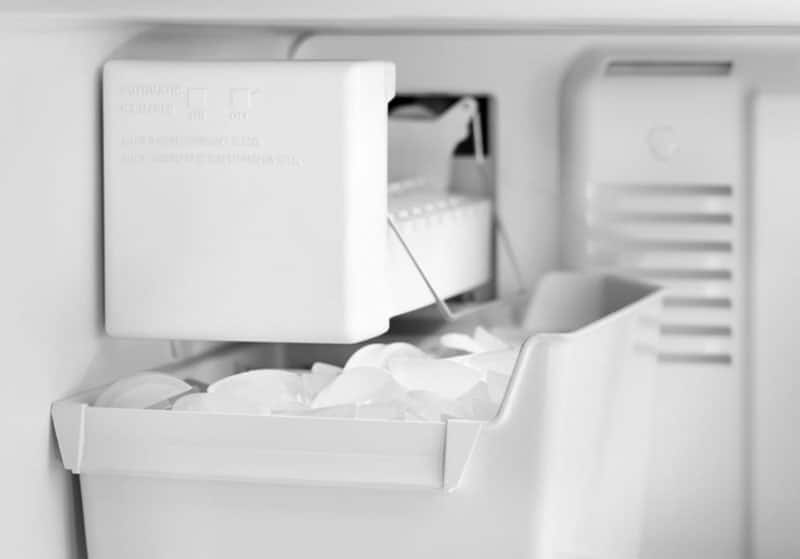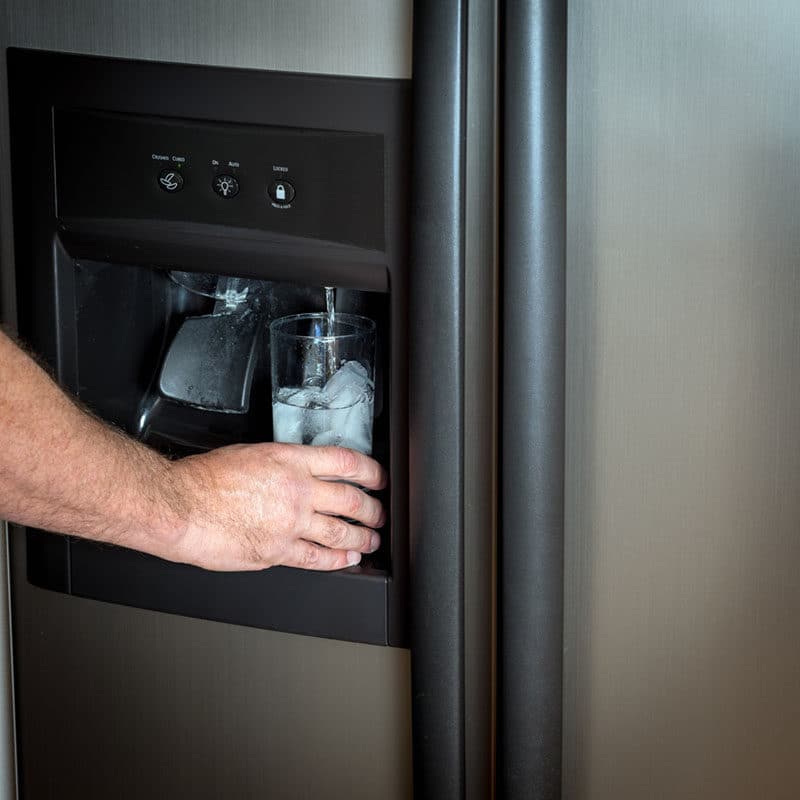Does an Ice Maker Continually Rotate
Wondering why your ice maker keeps overflowing with ice? I did too. After dealing with yet another watery ice spill, I looked into solving this problem myself.
The most common reasons why refrigerators overflow with too much ice is that the water pressure is too low, there may be a defective valve somewhere, or there could be a problem related to the ice chute.
If you want to fix your ice maker, you need to figure out which one applies to you.
So, are you finally ready to fix your overflowing ice maker? Do you want to prevent this problem from coming back? If so, take a look below, and figure out what is going on with your ice maker.
How Ice Makers Produce Ice
Before we can figure out why your ice maker is overflowing, it is important to learn more about how refrigerators produce ice. Your refrigerator is connected directly to your water supply. There is water that flows from the water supply into the ice maker. Then, water fills up the mold in your ice maker, producing ice cubes. If you decide you want crushed ice, then there is a motor mechanism that is responsible for crushing the ice cubes. Then, they flow through the chute into your glass.
If your refrigerator's ice maker is overflowing, this is a sign that your refrigerator is producing ice when it is not supposed to. Your refrigerator should have a sensor on the inside. The sensor is responsible for telling the rest of the system when the ice maker is full. When the ice maker is full, the water flow valve is supposed to stop. This prevents the refrigerator from making ice when it is not supposed to. So, what are a few of the most common reasons why your ice maker could be overflowing?
The Most Common Reasons Why an Ice Maker Overflows with Ice
If you find that your ice maker is overflowing with ice, there are several possible causes you need to explore. These include:
Check the Location of the Ice Bin
First, there is a chance it might only look like your refrigerator ice bin is overflowing. You need to make sure the refrigerator ice bin is in the right place. If it hasn't been placed properly underneath the ice maker, it's easy for ice to spill over the side of the storage bin. As a result, it may not fall inside the bucket. When this happens, it makes it look like your ice maker is overflowing. If you see a bunch of ice cubes on the ground, check the location of the ice bin. Make sure it has been positioned appropriately.

Inspect the Feeler Arm
It is also possible that something is wrong with the feeler arm, which acts as the sensor for your ice maker. If this arm has been broken, then your ice maker has no way of knowing when the bucket is full. If the ice maker cannot detect a full bucket, it will continue to produce ice. Eventually, the storage bin will overflow. Fortunately, it is relatively easy to replace the feeler arm. If you notice it's broken, you may want to reach out to a professional who can help you replace it. Or, if you have a lot of experience working with ice makers, this could be something you can do on your own. Once you fix the feeler arm, your ice maker should start working properly.
The Water Pressure Might Be Too Low
Next, you might notice that the water pressure is a bit low. If you have low water pressure throughout your home, it can be frustrating when you try to shower or take a bath; however, this is also something that can impact your ice maker.
Even though there are a few differences between ice makers, your water inlet valve requires at least 20 PSI to work properly. If the inlet valve is not sensing this water pressure, then the valve might not close all the way when the water is supposed to stop flowing. As a result, the water will continually drip into the ice maker.
When this happens, your ice maker receives far too much water. This will overfill the ice maker, freezing it completely. If you take a look at your ice maker and all you see is a singular sheet of ice, then there is a chance this is the issue. You need to take a closer look and check your water pressure to make sure it's appropriate. If you find that the water pressure is too low, you need to increase it before your ice maker can work properly.
You may want to check to see if there is a clog in one of your pipes. This could be the reason why the water pressure is too low.
The Water Inlet Valve Could Be Defective
Another common reason why your ice maker could be overflowing is that there is a defective water inlet valve. If you find that your water pressure is normal, this is the next location you need to check. Before you assume the water inlet valve is defective, you need to figure out whether you have hard water.
Hard water is a specific type of water that some homes have. What this means is that you have mineral buildup in your water. When this happens, it could cause your ice maker to overflow. There are plenty of water softeners you can use in your water system to alleviate this concern.
If you find that there is no mineral buildup, then you need to turn your attention to the water inlet valve. The problem with the inlet valve is that it may not be closing completely. If the inlet valve does not close, then water continues to flow into the ice maker. Then, you have the same problem as above.
Fortunately, this is a relatively easy issue to fix. If you have experience working with your ice maker, then you may be able to swap out the water inlet valve on your own. If this is something that you aren't comfortable with it, and you should reach out to a plumber for help. The vast majority of plumbers have dealt with this problem before, and they should be able to fix it relatively quickly.
The Chute in the Ice Maker Could Be Clogged
There's another possible reason why you have a singular sheet of ice in your ice maker. The issue could be related to the chute in the ice maker. If the chute is clogged, then ice is not going to be able to flow out of the ice maker. As a result, it will back up into the storage bin, causing it to overflow. As your refrigerator continues to produce more ice, the storage bin will continue to fill up. Eventually, your ice cubes make start to stick together, creating a single sheet of ice.
To alleviate this issue, you need to clean the chute. That way, you do not have to worry about a clog from developing in the system. It's relatively easy for you to clean the ice maker. You simply need some water, a vinegar solution, and a damp cloth.
These are a few of the most common reasons why your ice maker could be overflowing. Take a look at these issues above and see if they apply to your ice maker. Then, it is important to prevent this issue from coming back. How can you do that?
Prevent Future Problems with the Ice Maker
Because it can be frustrating to deal with an ice maker that's overflowing, you need to make sure you prevent this problem from happening in the future. There are a few ways you can do exactly that. These include:
- Invest in Regular Plumbing Maintenance: First, you need to make sure that you get your plumbing system maintained on time. This is important for several reasons. First, if you get your plumbing system maintained, you can identify issues related to your water pressure before they start to impact your ice maker. That way, you don't have to deal with low water pressure. Second, you can also prevent mineral buildup in your plumbing system. Mineral buildup is another common reason why ice makers start to overflow.
- Clean Your Ice Maker: You can also prevent issues with your ice maker by cleaning it regularly. Once per month, you need to disassemble your ice maker and clean it using a solution of water and vinegar. Then, make sure the ice maker is completely dry before you put it back together. This can prevent dirt, grime, and contaminants from damaging the ice maker.
- Do Not Abuse the Ice Maker: Finally, you need to be gentle with the ice maker. Even though it can be frustrating if your ice cubes start to clump together, avoid using sharp objects to break up the ice clumps. If you use sharp objects, you could mistakenly go right through the ice and damage the ice maker. You may damage the water inlet valve or break the feeler arm. This can lead to serious problems with the machine.

If you keep these tips in mind, you should be able to prevent future problems from developing with the ice maker. That way, you don't have to worry about it overflowing in the future.
Learn How To Deal with an Overflowing Ice Maker
Even though there are lots of possible reasons why you might have an overflowing ice maker, these are a few of the most common examples. Remember to make sure the ice bin is positioned underneath the ice maker. You also need to make sure the feeler arm is working properly. Check to make sure the water pressure is high enough and ensure the water inlet valve isn't damaged. If you go through these steps, you should be able to figure out the problem with your overflowing ice maker.
If this article has helped you, then why not check out some of our other articles and free guides. You can even sign up to our email list.
Have a great day!
-Craig
harveymandivether.blogspot.com
Source: https://applianceanalysts.com/ice-maker-overflowing/
0 Response to "Does an Ice Maker Continually Rotate"
Post a Comment